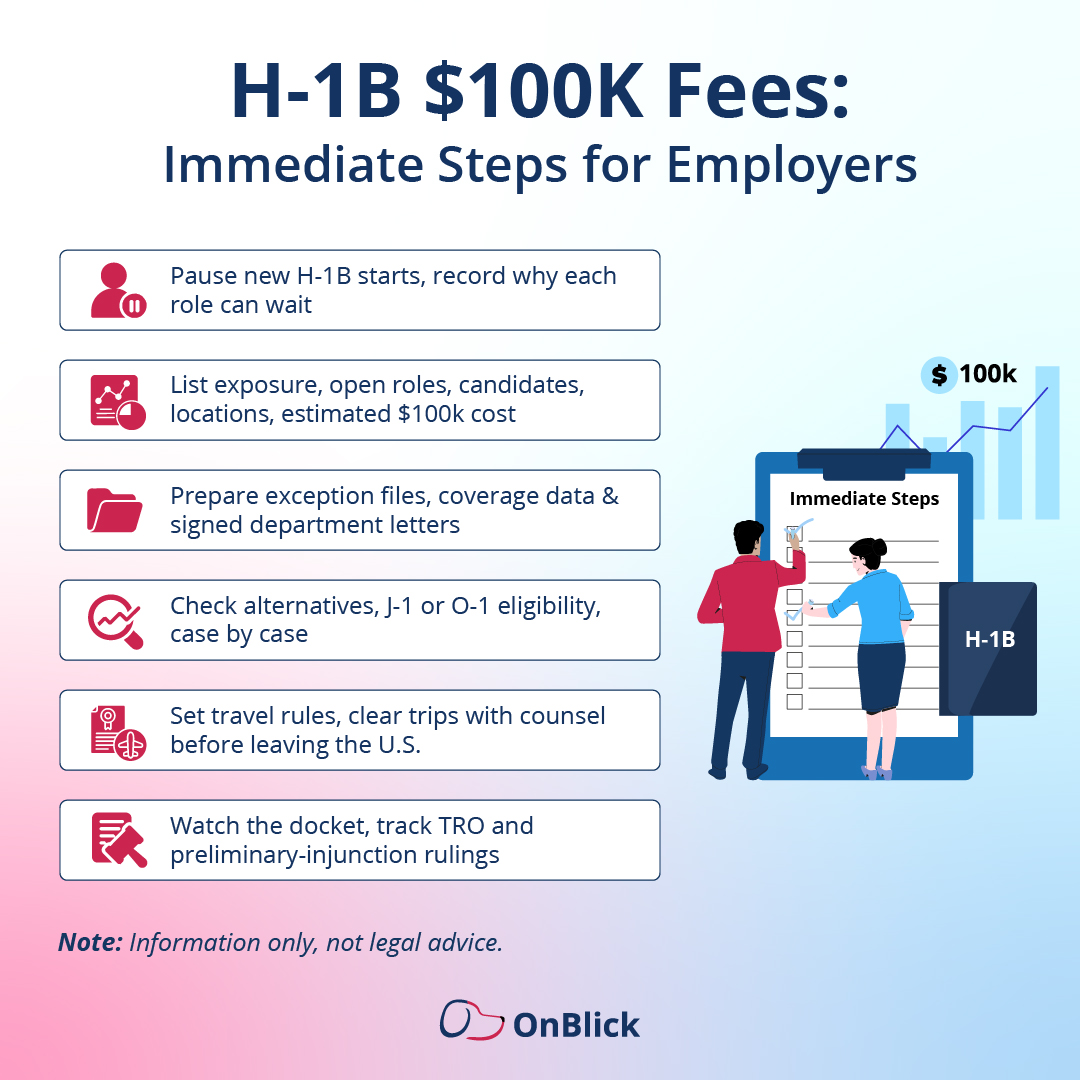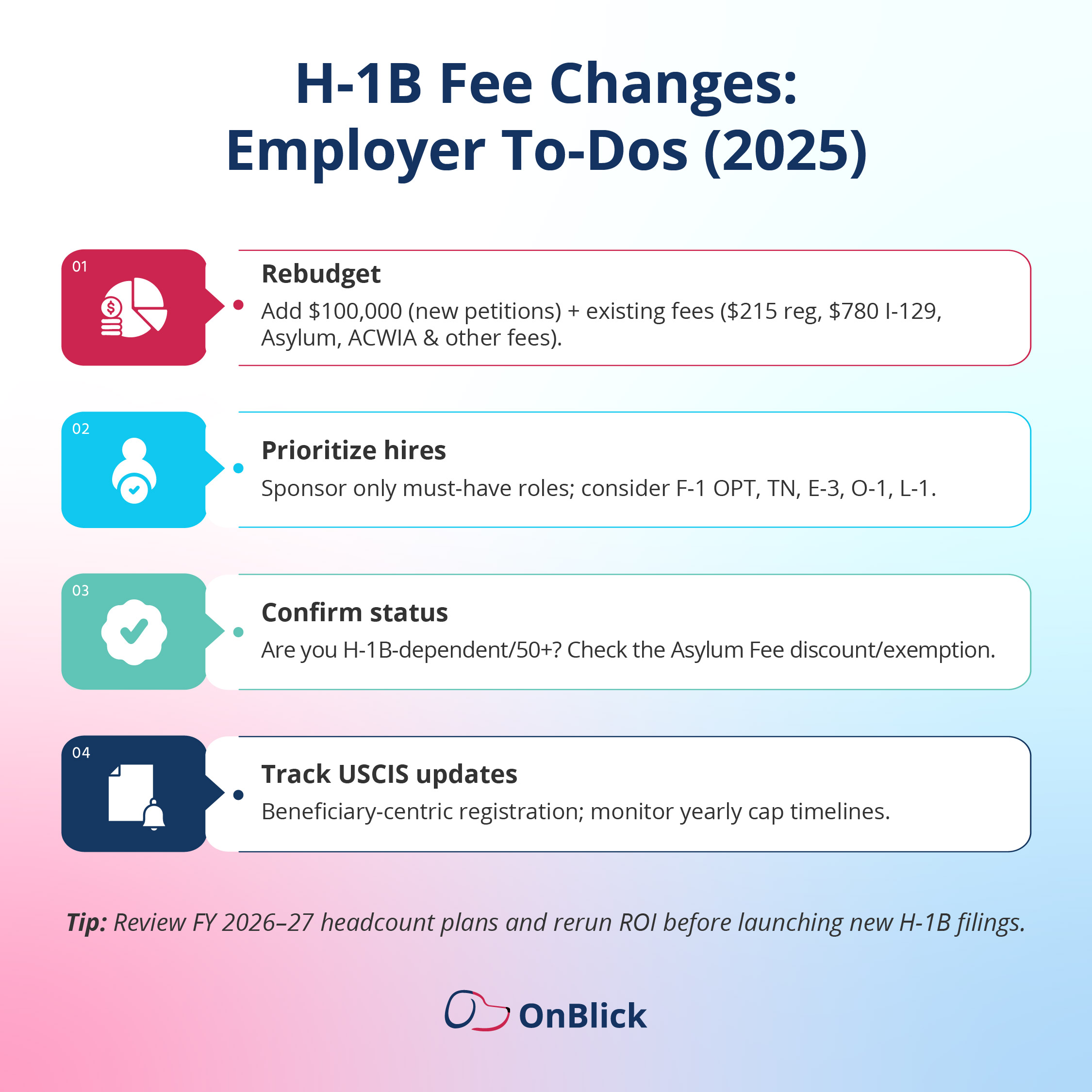Learn More

On September 19, 2025, the White House issued a proclamation that ties H-1B entry to a $100,000 payment from the sponsoring employer. The rule took effect on September 21, and many employers, universities, and hospitals are reassessing hiring plans while details remain unclear. A broad coalition has filed suit in the Northern District of California to block the requirement. Teams need a clear read on what changed, who is challenging it, and what steps to take now.
This article discusses the proclamation, the lawsuit, key dates, and immediate steps for employers.
On September 19, 2025, the White House issued “Restriction on Entry of Certain Nonimmigrant Workers.” It limits H-1B entry unless the sponsoring employer makes a $100,000 payment. The order takes effect 12:01 a.m. EDT on September 21, 2025, runs for 12 months unless extended, and allows national-interest exceptions at DHS discretion. The text also directs State and DHS to verify payment during processing and calls for separate wage and selection rulemakings.
On October 3, 2025, a coalition led by Global Nurse Force sued in the U.S. District Court for the Northern District of California, Case No. 3:25-cv-08454, assigned to Judge Joseph C. Spero. Plaintiffs include labor groups, educators, healthcare and faith organizations. The complaint argues the proclamation exceeds presidential authority under INA §§ 212(f), 215(a) and violates the Administrative Procedure Act.
The amount is $100,000. State Department guidance says the restriction applies to H-1B visa issuance and entry based on petitions filed with USCIS after the effective time on September 21, 2025, 12:01 a.m. EDT. The page notes that DHS will handle exceptions and confirms no visas were revoked under this order. Agencies may issue more clarifications for edge cases such as extensions or amendments.
Pause non-critical new H-1B starts, map exposure, prepare a national-interest exception file for critical roles, and track the docket for TRO or preliminary-injunction activity.
The proclamation, Restriction on Entry of Certain Nonimmigrant Workers, makes admissibility for H-1B workers contingent on proof that the sponsoring employer has made a $100,000 payment. It frames this as a condition of entry, not a new USCIS filing fee, and directs DHS and State to build the checks that confirm payment during petition and visa processing. DHS may grant case-by-case national-interest exceptions, with criteria and documentation to be defined in agency materials. The text leaves several mechanics to implementation, including what counts as acceptable proof of payment, when proof must be shown in the workflow, and how special filings such as portability or amendments will be treated. It also anticipates follow-on agency actions related to selection and wage policy, which would proceed through separate processes.
.jpg)
Public-facing materials from USCIS and the State Department reference new H-1B petitions after the effective time, with additional clarification expected for edge cases such as amendments, portability, cap-exempt filings, and in-country change-of-status.
Case: Global Nurse Force et al. v. Trump et al., No. 3:25-cv-08454 (N.D. Cal., filed Oct 3, 2025), before Judge Joseph C. Spero. Plaintiffs include Global Nurse Force, UAW affiliates, AAUP, K-12 charter networks, and religious organizations.
Key claims in the complaint
Early posture: The complaint is filed and docketed. Parties are preparing for emergency relief proceedings.
Several institutions have issued internal travel cautions while they assess exposure.
(Information only, not legal advice)

Does the $100,000 fee requirement apply to extensions with the same employer
Current public materials focus on new petitions after the effective time. Wait for specific agency instructions on extensions, amendments, and portability.
Are cap-exempt universities and nonprofits covered
Unclear in published materials. Institutions have asked DHS and State to clarify treatment for cap-exempt filings.
Is this an entry restriction or a filing fee
The proclamation frames it as entry, and agencies reference payment verification during petition and visa processing, which is why new petitions are in focus.
How to build a national-interest exception file?
This aligns with the proclamation’s exception concept.

OnBlick will continue to monitor the Proclamation and other changes to the H-1B visa to offer more details as they become available. If you wish to know more about OnBlick’s H-1B services, book a free demo today.
Disclaimer: This article provides general information only. It is not legal advice.